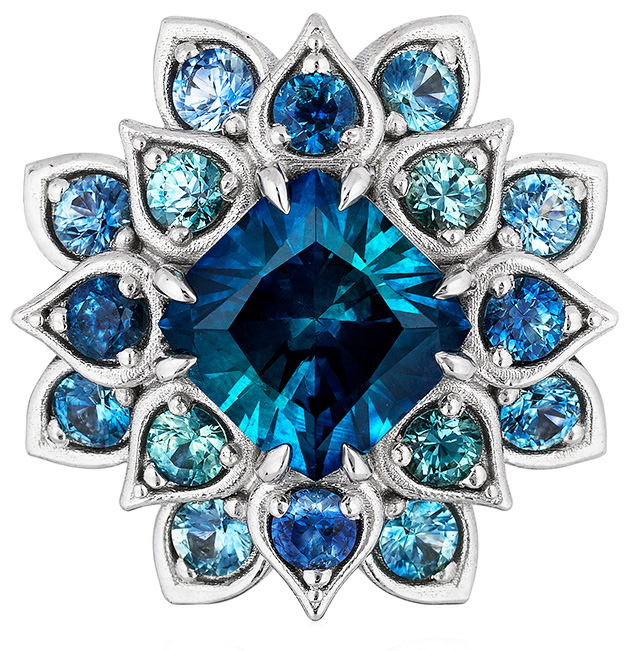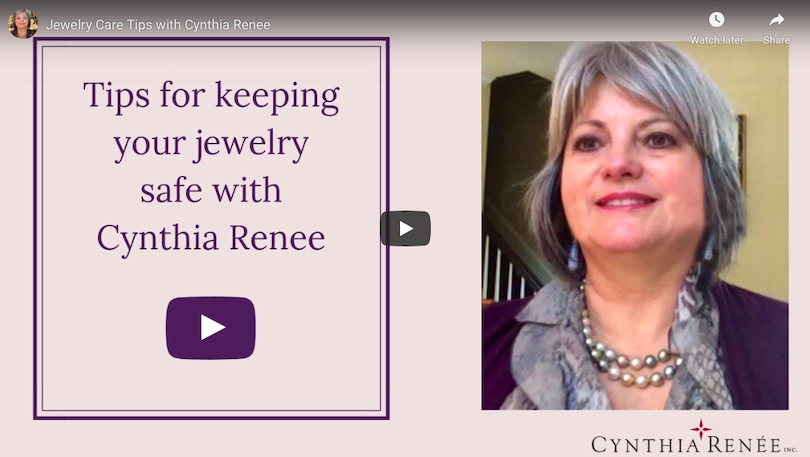JEWELRY WEAR & CARE
With proper care, your jewelry has been designed and crafted to endure and be handed to future generations.
Removing your rings before housework, sports, gardening, moving day . . . all activities where your hands are active, prone to blows or involved with abrasives &/or caustic chemicals. Put your jewelry on after you apply cosmetics, hair products, sunscreen, lotions and perfumes.
Taking your jewelry off before your shower, bathe, swim in a chlorinated pool or wash the dishes. Chlorine can damage your jewelry, especially when your jewelry is subjected to it consistently over time, as in the shower. Chlorine is not generally a problem for platinum or palladium jewelry, yet removing it is a good habit to form. We recommend having a ring spindle at your kitchen sink, desk and bathroom as a safe consistent place to place your jewelry when you remove it. This is what can happen if you store it in a tissue
Wearing gloves while lifting weights isn’t enough protection for your rings. It subjects your ring’s metal to potential damages from tension or stress due to differential application of stress when you are lifting. This can result in misshapen shanks, broken prongs, lost gems.
Behaving as you would when wearing a nice silk blouse: You enjoy wearing your fine jewelry, while paying extra attention to your actions. You wouldn’t wear your silk blouse to fry chicken would you? Likewise, start developing the mindset of what is appropriate wear for your jewelry to keep it safe.
Cupping your Claps! You may be surprised that enthusiastic clapping can seriously damage fine rings. Protect your ring by clapping with cupped hands, where the rings don’t’ slam into each other. Learn more with our blog post “Don’t Damage your Rings Clapping, Fangirl!”
Storing your jewelry pieces separately, so they do not scratch each other. Don’t jumble it together in one bag and take it traveling – gems will get scratched, earring posts bent, prongs pulled – it will get damaged. Instead, put the individual items into small ziplocs which you then put into a large ziploc.
Not wrapping your jewelry in tissue or a paper towel for temporary safekeeping – this is a VERY common way jewelry gets thrown away when you come back later and just toss the tissue.
Storing your necklaces, whether metal chains or beaded, laying flat or gently coiled – never hang them. Necklaces stretch! Gently wipe your chains, beads and pearls with a soft, clean cloth after wearing to remove skin oils and perspiration.
Having your gems professionally cleaned and checked for secure settings once a year
PEARL CARE
Pearl items should be stored individually – not with other jewelry materials, as they are softer and can be scratched.
Do not store pearls in a plastic bag, as plastic can off-gas a chemical than can cause damage to your pearls.
Pearls can be harmed by contact with many chemicals, such as those found in household cleaning products, perfumes, hair protects and cosmetics. Apply perfumes, hair products and cosmetics BEFORE you put your pearls on.
After wearing, gently wipe your pearls off with a clean, soft cloth to remove skin oils and perspiration; be sure that cloth is clean, as any grit in the cloth could scratch your pearls.
Never use an abrasive material or a toothbrush to clean your pearls – even those cleaning products presented as “gentle” or “organic” – or put your pearls in an ultrasonic, ionic or steam cleaner. Only use jewelry cleaners labeled as safe for pearls.
Keep your pearls away from direct heat sources, such as never set them by a stove, on a warm tv, a fireplace mantle or prolonged direct sunlight, such as leaving them on the seat of a hot car.
A little humidity is good for your pearls – they like moisture just like our skin. Because of this, do not store them in an air less environment such as a safe deposit box for prolonged periods, or even in a very dry room. Wear them; pearls want to be worn.
Remove your pearls before exercise or sauna; the pH in our sweat is caustic for the pearls.
Do not drop your pearls on a hard surface, such as cement.
If your pearls get some drips or spills, immediately wipe them clean or soak in lukewarm water with a gentle natural soap (NOT detergent) then let them dry thoroughly before wearing. If immersing a strand of pearls, they will probably need restringing after immersing in water.
Pearl strands do need to be restrung – sometimes once a year if worn often.
GEM CARE
Opal and Amethyst have the same hardness of 7. But, remember, hardness is not the same as durability. Jade is not hard, yet is very durable because of its internal structure; topaz is hard but due to its cleavage is not as durable. Opal and amethyst have the same hardness but due to internal factors, opal is not as durable.
Cynthia Renee can help you selecting a gem of the durability suitable for your lifestyle and give you specific care instructions.
CLEANING YOUR JEWELRY
Remove your jewelry before showering or bathing, washing your hands, applying hand lotion and doing the dishes. Not only is this potentially damaging for the jewelry, but soap deposits build up on the gems and settings which dull their brilliance.
Cynthia Renée, Inc. provides jewelry cleanser and a polishing cloth with every purchase. See the directions in that kit for more details on how to use.
JEWELRY CARE & STORAGE MUST-HAVES
These are the items I most recommend to clients over my 30 years as a jewelry and gem pro. Properly cared for, your jewelry will be enjoyed over generations.
To see more of Cynthia’s custom jewelry design work, click here.

Discover how your jewels can be a guide to personal transformation.
CONTACT
FOLLOW


